



Following any cosmetic surgery with the Plastic Surgery Group of Memphis, you will go through a healing process that will vary depending on the procedure. For the best results, you should always follow your plastic surgeon’s instructions, but it also helps to have some understanding of wound healing, what you can do to expedite, and how you can be sure your scars are healing properly.
One of the most common concerns among patients is having an obvious scar after a procedure. Plastic surgery usually involves at least one incision in the skin, and like any injury to the skin, this can result in visible scars. Our experienced plastic surgeons know where to place the scars to make them less noticeable, and most people heal well. However, some patients may have trouble with scarring due to various issues including delayed healing, superficial infection, and poor postoperative wound care. There may also be a genetic predisposition to a type of scarring called keloids. Because the wound healing process has four distinct phases, you can be aware of what is normal and what is not during the recovery process. Knowing when to contact us is crucial in minimizing scarring and avoiding complications.
The four phases of wound healing
Our bodies have an enormous capacity to heal themselves thanks to our immune system. When an injury occurs – or in this case, a cosmetic surgery procedure – the immune system is designed to launch an intricate reaction on the cellular level in order to restore tissue integrity as quickly as possible. This built-in response to wound repair occurs in four distinct phases.
Hemostasis
When surgical incisions cause injury to the tissues and blood vessels, the vessels have the ability to constrict themselves, reducing blood flow. This is referred to as hemostasis, which simply means “the stopping of blood flow.”

Inflammation
After hemostasis occurs, a series of cellular reactions begin, signaling the body to introduce inflammatory cells to the injured area. The area may then become warm, red, or swollen as the inflammation initiates blood clotting and the first steps of healing. This form of inflammation is beneficial. Powerful immune cells quickly infiltrate the wound, and will continue migrating to that area over the next 48 hours. From this position, they are able to fight against any pathogens that try to enter the wound, consuming or destroying them with their own toxic substances. This helps to sterilize the wound.
For the first 48–72 hours after the injury occurs, an entire range of immune cells move into the wound where they begin to build a new network of tissue and remodel the collagen. The inflammatory stage will last as long as the body needs in order to heal. If you experience any prolonged inflammation, you should let us know immediately, as this could indicate an infection or another problem.
Proliferation
Generally, the signs of any serious disease-causing bacteria or viruses will disappear within 3-10 days. At this point, the inflammatory response declines, and the body will reach the proliferation stage, which is where most of the tissue repair occurs. Through the intricate process of cellular action, the body will begin to repair any damaged blood vessels. Cells will then start to lay down new structural proteins and remodel tissue by producing collagen and the other fibers that form the structures of the tissue.
Tissue remodeling and maturation
After a week or so, wounds will begin to contract. The cells pull together more tightly in order to reduce the area that needs healing and to allow the formation of scar tissue. This is the most important phase when it comes to the visual appearance of scars. Any disruption during this stage could lead to a contracture or a scar that is not cosmetically appealing.
As the wound goes through the healing process, scars will usually appear a light red or pink at first, then begin to fade over time. The entire tissue remodeling stage can take up to two years to complete, but generally speaking, the tissue is recovered enough after a few weeks that normal daily activity can be resumed.
How to minimize scarring after plastic surgery
While there will always be some genetic component to the way you heal, there are a couple of therapies that have been shown to successfully minimize scarring after plastic surgery.
Scar massage
During the second phase of wound healing, the new scar tissue is immature. With adequate massage therapy, you can sometimes prevent this scar tissue from becoming permanent. Frequent, vigorous massage of the area can improve its appearance over time.
Silicone Sheeting
This option has been clinically studied extensively. A sheet that is lined on one side with silicone gel is placed directly over the scar, relieving redness, pain, and itching while improving the overall appearance of the scar.”
The position or alignment of the scar on the body can play a large part in its appearance, and some scars may require methods such as steroid injections to improve their quality. However, elective cosmetic surgery comes with the benefit of preoperative planning, allowing our surgeons to place scars in the most inconspicuous positions. These types of wounds often heal more favorably thanks to the ideal conditions under which they occur, and because you will know the exact location of the incision prior to your surgery, you’ll be able to plan ahead for any recovery outcome.

When to call your plastic surgeon
During the recovery process following your plastic surgery procedure, you’ll need to keep an eye on the incision as it heals. It will go through the four phases listed above, and you may find yourself wondering during any one of them if what you’re experiencing is normal, or if something is amiss. Infections are rare, but they can happen, usually within the first month after surgery. If you notice any of the following, please contact your plastic surgeon immediately.
Here at the Plastic Surgery Group of Memphis, we want to give you not only the best results with minimal scarring, but the best overall experience as well. You can help advance your own recovery process by always following your surgeon’s pre- and post-surgical advice, and by being aware of where you are in the healing process. If you experience any difficulties, get in touch with our office and we will do all we can to set your mind at ease and keep you feeling calm, comfortable, and pleased with your procedure and progress.